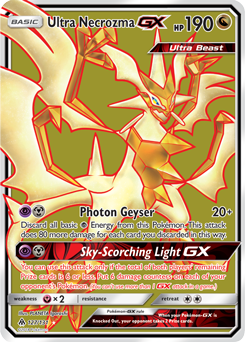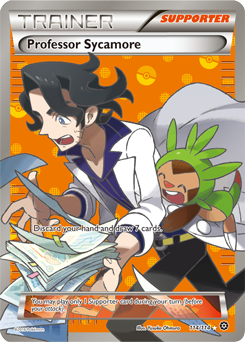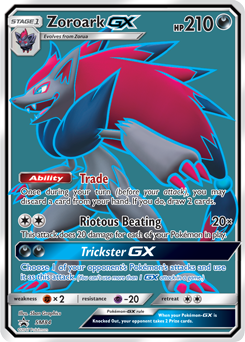Preparing When You Can’t Playtest — A Guide for the Busy and Bored
Editor note:
Unfortunately we were unable to get this article up before Toronto however the vast majority of this article is written as a very general guide for all tournaments. We apologize for any inconvenience!

Hello again! It’s been months now since the release of Ultra Prism, and we are finally coming to the end of what has been a thoroughly interesting BKT – ULP format. After seven Regional Championships, eleven Special Events, and the Latin American International Championship, we’ve arrived at the final weekend of tournaments before Forbidden Light becomes official! There may have been plenty of exciting decks to have performed well over the tournaments of this format, but it’s perfectly understandable if you don’t care about any of them! After all, Forbidden Light is preparing to bring with it plenty of exciting new concepts, including potentially great cards in Ultra Necrozma-GX, Zygarde-GX, Greninja-GX, Malamar, Beast Ring, and more!
While it may be easy to look ahead to the upcoming excitement of the new set, for many of us there is still one major event that remains: the Toronto Regional Championships. Even for those who are not attending the Regionals, vital League Cups and Challenges remain, ever-important sources of points for those looking to bolster there chances of obtaining that Worlds invite. The idea of trying to playtest for this last week of events may sound rather boring, and can be easy to ignore, particularly for those attending a future Regional Championship where Forbidden Light will be legal (such as in Roanoke or Madison). So, for this article, I’ll be writing about what to do if you haven’t had time to playtest for Toronto, whether by choice, or by chance. This tends to be a rather common scenario: there’s a major tournament ahead, but you haven’t had time to practice for it! While there are tons and tons of players extolling playtesting as the key to success (and frankly, it is incredibly important), reality also means that there are plenty of times where adequate playtesting simply isn’t an option. Perhaps you’ve been busy with work, or with school. Maybe you’ve gotten sick, or something’s come up that’s been taking away your free time. You know, when that weird, non-Pokemon related part of your life gets in the way of all of your planned testing and practicing. Alternatively, you could just be bored with the format, especially at the end when you could instead be testing out exciting new cards and concepts.
So, what should you do when you find yourself in that situation, when you haven’t had much time for playtesting, need to make a last-minute deck decision, and yet want to have the best chance of winning? Read on, and I’ll give you my approaches to solving this dilemma, some solid last-minute decklists, and more!
In addition to being useful for those players in that unfortunate scenario, this article’s advice is also excellent advice for any Junior / Senior player, particularly those who are looking to step up for the first time into the competitive side of the game. For younger players in particular, constant deck-changes or concept introduction can be difficult to grasp, and attempts to force such changes in an effort to better be prepared for the meta can easily backfire. By accounting for the increased learning time for newer players, you can avoid such pitfalls, and instead give them the best chance for success, even at times when they may seem under-prepared. For both the bored Master and the excited new Junior, the first piece of advice I would give is:
Stick With What You Know

This seems fairly obvious, but it can also be one of the hardest concepts to stay with, especially when you want to try and get ahead of and plan for the format that you’re going to be playing in. That said, for players with limited time for playtesting, sticking to a well-established concept can do wonders for their tournament results. It’s much easier to climb a mountain if you start near the top, as opposed to the bottom. Likewise, it’s much easier to master a Pokemon deck if you start with a deck you already know incredibly well! Rather than constantly switching and having to start learning matchups from scratch, you can perform much better if you only have to learn matchups against the few new decks that pop up with each new tournament or set release. If you’re light on time, this can be a huge difference; rather than only being able to learn some of your matchups at a shallow level, you can instead focus on those newer matchups, and thus master them to a much deeper level than you would otherwise be able to. When added to your accumulated deck knowledge, this means that rather than knowing all matchups only decently, you’ll instead be able to know pretty much every matchup inside and out. For junior players, this strategy also allows you to hammer home more complex strategies that may otherwise be lost in the effort to grasp a new deck. In addition to knowing their matchups better, this will also improve their understanding of their own deck, and concepts of the game as a whole! When my younger brothers and myself were first learning how to play competitively, we rarely switched decks, for this very reason. While it may be very tempting to try and push them to the newest tier-1 deck, particularly in cases where their current deck has become less competitive or is being targeted by other players, the benefits of doing so may not be worth it if they can’t adequately grasp the new concept quickly enough.
Likewise, if you’ve been playtesting a lot with a particular deck, don’t make a last-minute switch to a new, exciting concept unless you can put in the time to adequately learn the new deck. Rather, go with the choice that you know well. Even if the hot new deck might be a better meta call, those advantages can be easily negated if you don’t know the best way to approach certain matchups, or certain little tricks and plays that can be critical to that deck’s success. In many situations, making a late deck switch to an untested deck can be actively detrimental, since you lose those aforementioned advantages that you would otherwise have with your other, tested option. If you’ve been playing one deck for the past few months, stick with it for the last week! Many top players consistently stick to their particular deck of choice – prominent examples include Xander Pero with Espeon/Garbodor and Tord Reklev with Zoroark — so you shouldn’t think that you have to switch constantly in order to have success.
In my own experience, mastering and continuing with a single deck concept was critical to being able to maintain a decent level of competitiveness during times where my playtesting was sparse or nonexistent. This was the case for my first few years of college; with no car, not much time to playtest, and plenty of other distractions (such as, you know, going to college), there was no way that I was going to be able to switch from deck to deck and still remain a competitive player. So, rather than fruitlessly attempt to do so, I had one deck that I would play whenever I went to a tournament.
During that time, my deck of choice was Plasma, first as a Colorless-based variant, then later as the popular deck TDK. (For those unfamiliar with it, these decks utilized Team Plasma Pokemon such as Thundurus-EX, Kyurem, Deoxys-EX, Absol, and Tornadus-EX, while taking advantage of cards designed to benefit them such as Colress Machine and Team Plasma Ball.) This was my go-to deck since its release, pretty much up until it became completely outpaced in the format (around the time of Phantom Forces). Over two or so years of playing the deck, I was able to get back-to-back Top 64 finishes at US Nationals, a Top 8 Regionals finish, a first place State Championship finish, as well as some competitive finishes in other events. That success, while modest in comparison to some of the heavyweights of the time, was certainly enough to keep me happy and competitive, despite never switching decks during that time. While my success certainly went up and down with the deck’s spot in the meta, I was able to have a chance just about every time I played. The main trick was that I knew how to play Plasma very well, and so was able to eventually pick up the strategies for dealing with certain matchups, despite the lack of outside playtesting.
Once you get to the point that you know your own deck’s strategies inside and out, it can be remarkably easy to adapt it to account for the changes in popularity and makeup of other decks. With enough tournament play, you’ll have plenty of knowledge of your deck’s strengths and weaknesses. From there, you can look at tournament results and set releases, acknowledge the most popular and best performing decks, and from there adjust your list to best fit into the expected format. Most of the time, you likely won’t change much at all; the exceptions to that often come after the release of new sets and/or the introduction of new cards into the format (such as promos).
If this is you, or you expect to find yourself in a similar scenario, picking a deck to stick with over the next while is a great step to remaining competitive. You more than likely have an idea of your own play-style and strengths and weaknesses as a player – pick a deck that adapts to those attributes.
Planning Ahead

For the long-term, it’s often best to plan ahead if possible. That is, if you have a feeling that a particular deck will remain competitive not just for the near future, but for the long-term as well, that deck would be a great pick as your go-to deck. These concepts can often be apparent when Pokemon seemingly “gives you” an archetype in a set (or over several), such as they did for Plasma Pokemon back in the day. Other great examples of that include Virizion-EX / Genesect-EX decks (which was the “obvious” archetype from Plasma Blast) or SP decks (back in the Diamond/Pearl era). Whenever a deck seems overwhelmingly strong, it also is more than likely to stick around for a while, and thus makes a good candidate for a long-term deck. Bad choices for this include “meta-call” decks or decks which have obvious weaknesses in upcoming sets. Rotations are also something to be well-aware of – you don’t want to pick a deck if the main attacker is going to be gone in September! Likewise, picking a deck immediately after a rotation or right after a new deck comes out can maximize your time to use it. Currently, Zoroark-GX and Ultra Beast based decks seem well-positioned for the long term, other possible choices include VikaBulu and Gardevoir-GX decks. In Expanded, you don’t have to worry about that rotation, just the occasional ban. Decks such as Trevenant have been around for years now, and as such many expanded decks can be maintained in your arsenal for as long as they remain viable.
Even if you aren’t necessarily going to find yourself in a long-term playtesting drought, you can still utilize this idea in the short-term as well. For those of you who have been more than happy to ignore the current format in favor of the more exciting Forbidden Light meta, another strategy you can take is to use this weekend as a pseudo-testing ground for your future deck. What you can do, if you know what you want to try and do after this weekend, is to play the analogous deck for this weekend’s events, since much of the gameplay and strategy will be the same. This strategy will work best with decks such as Espeon-GX / Garbodor or Buzzwole-GX / Lycanroc-GX; that is, decks which already exist in our current meta, but also look to be highly competitive once the next set becomes legal. This also works in reverse; if you know you won’t have too much time to test the Forbidden Light cards, you can stick to one of these decks, and thus not have to replicate your testing with a new deck.
This concludes the public portion of this article.
If you'd like to continue reading, consider purchasing a PokeBeach premium membership! If you're not completely satisfied with your membership, you can request a full refund within 30 days.
Each week we post high-quality content from some of the game's top players. Our article program isn't a corporate operation, advertising front, or for-profit business. We set our prices so that we can pay the game's top players to write the best content for our subscribers. Each article topic is carefully selected, goes through multiple drafts, and is touched up by our editors. We take great pride in our program!

